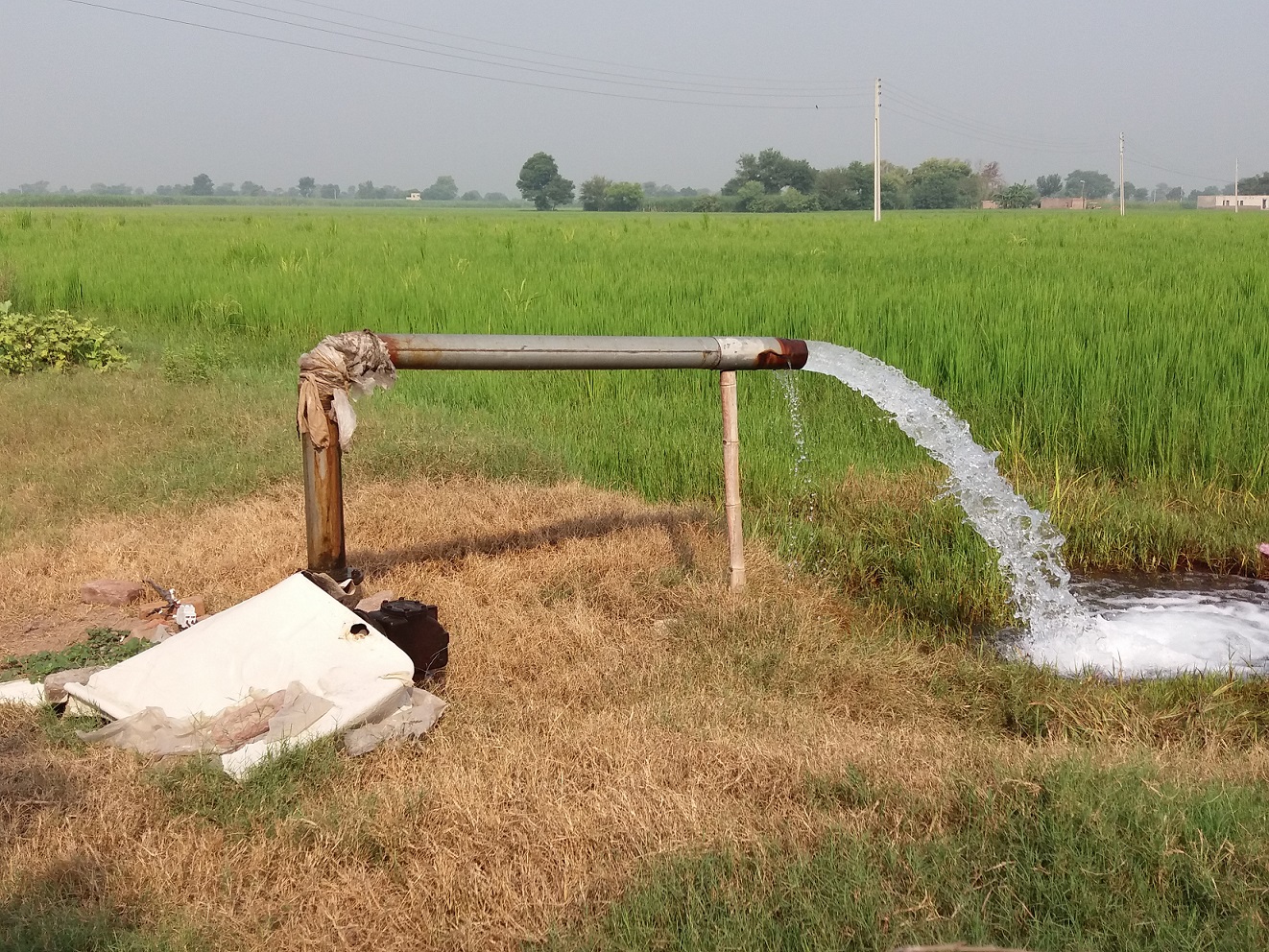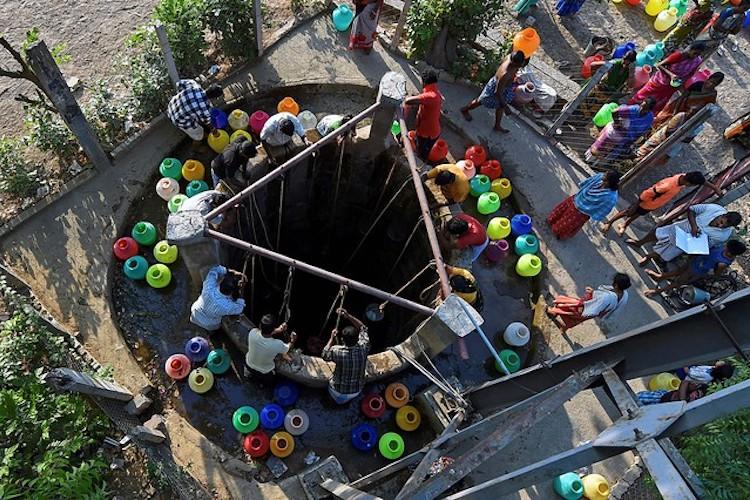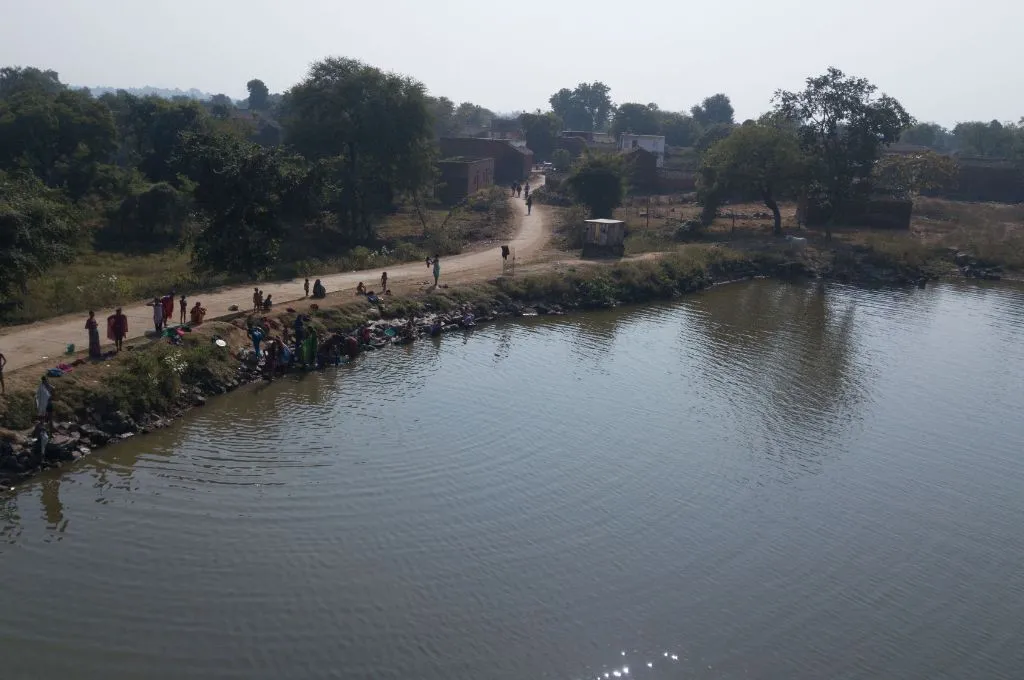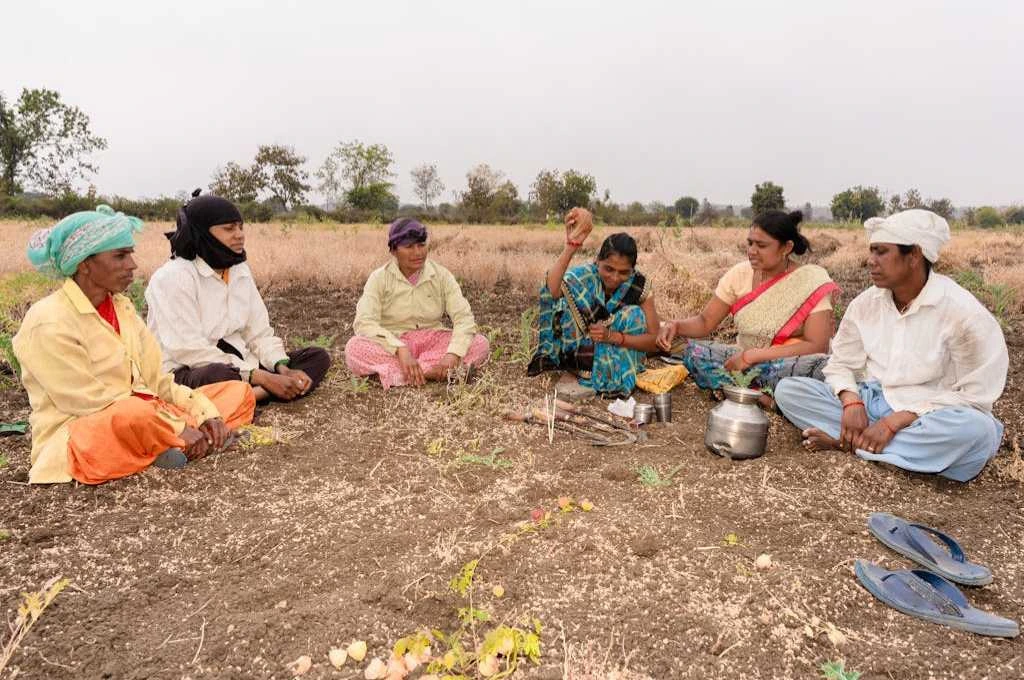Edited transcript of the episode:
00.42
Smarinita: India is the largest user of groundwater in the world, with more than 80 percent of our population depending on it either for drinking water or for irrigation in agriculture—making it a lifeline for many citizens in the country. When we talk about groundwater, we are essentially talking about the water that is found below the earth’s surface. It acts as a critical buffer against the variability of monsoon rains, which have become even more unpredictable due to climate change. In large and small cities, we are also seeing residents beginning to rely more and more on groundwater due to unreliable and inadequate municipal water supplies.
Essentially, we are a groundwater economy. We also have a groundwater problem.
The overextraction of water through the years is threatening the overall water security in the country. What makes this resource even more difficult to manage is that it is invisible to the naked eye. And often, what is out of sight is out of mind.
Chatting with us today on the state of India’s groundwater, and discussing what’s happening on the policy side and what’s shifting in practice, are our two guests—Mala Subramaniam and Dr Himanshu Kulkarni.
Mala is the CEO at Arghyam, a foundation that takes a data-driven approach to help transform India’s water and sanitation systems. Her work focuses on mapping out a sustainable water security journey for governments, nonprofits, and communities. Dr Himanshu leads ACWADAM, a knowledge institution and think tank on groundwater. A hydrogeologist by qualification, he has been actively involved in the advocacy for stronger programmes on groundwater management in India for close to four decades.
02.22
Smarinita: Mala, coming to you first—could you talk a little bit about the level of understanding that both governments and communities on the ground have about groundwater and the role that it plays in India’s water security?
Mala: So if I look back a decade, when I joined the sector, groundwater was a much neglected, much misunderstood, un-understood resource. There was not much mainstream attention that it got from policy or in practice. But if I trace the journey over the decade, that situation is very different now, thanks to the pioneering work that the community of practitioners has done. Today, I don’t think there is a policy discussion on water security in India that doesn’t call for the importance of maintaining, restoring, and conserving groundwater. So there is a seminal shift, at least on the policy front. A lot of good reforms and governance in terms of intent have been expressed. [This is] either in the form of states attaching funds and programmes [related to groundwater] or at the national level where we have the Atal Jal Yojana, which is a large, seven-state programme that is intended to bring communities [together] and build water security through local planning and understanding of groundwater.
There is an understanding that people at the front line—bhujal jan guards, jal surakshaks, jal doots—are required to manage groundwater. They are central to many large programmes. The role of Panchayati Raj institutions in understanding groundwater [is also key]. I think the ground has shifted a lot in the right direction. There is a lot more that needs to happen. But in terms of just the shift in policy, I think that’s quite tremendous.
04.10
Smarinita: What about the communities themselves? What does their understanding of water look like today?
Mala: I probably wouldn’t say that the understanding of communities or the engagement of communities is where it needs to be. There are many reasons for that. I think as communities, the sense of ownership of local resources, and the ability and agency [over those resources]—there’s a lot of gap there. And that needs to be built. And a lot of these programmes are bringing that back. Because that abdication has happened—that someone needs to manage this and give [communities] water. And therefore [there is a] disconnect between local resources and the ability to manage. So I would probably say that there is a gap there that needs to be filled. But then again, we need to look at what are the incentives that can make that happen. And a lot of these programmes’ intent is to do that. The ‘how’ of it is the question, and we need to look at that and explore that a bit.
05.06
Smarinita: Himanshu, you work extensively with communities as well. Do you agree with what Mala is saying—that a lot more needs to happen when it comes to engaging communities in the groundwater crisis?
Himanshu: Yes, I completely agree with what Mala has just said. I will actually go on to add another dimension that is coming out through how communities question the government, how communities are actually coming forward to seek answers to some of their questions. And the questions are different. So if I actually paraphrase the questions that communities were asking me as a researcher 40 years ago, and what they’re asking us as an organisation in the field 40 years hence, [they] are completely different. Let me give you an example. Forty years ago, the questions were around where do I site a well, or a borehole or a tube well, in my piece of land. Can I bring a water diviner? Or should I go to a scientist? That’s a question from 40 years ago. It’s not as if people are asking the same question now. Fifteen years ago [too], the question was very different—wells are drying up and we are putting in deeper and deeper wells, deeper and deeper boreholes. And with that comes a different set of problems. How do we resolve this problem? Is it climate change? Is it something that we are doing? And now there are questions like, is there some relationship between the extraction of groundwater in our region and the drying up of rivers that flow through our villages? Or for that matter, something like, are we extracting too much? And is our extraction affecting our groundwater quality in some way or the other?
So if you just look at these set of questions across a 40-to-50-year period, the problems are different. The crisis is upon us. But I think it has, if not anything else…it has brought groundwater into the limelight of discussions on water, discussions on agriculture, discussions on the overall growth, development, and sustainable solutions around water. These discussions are progressing towards the interface between groundwater and the environment. And that is a positive sign. It harbours well, in terms of going forward.
07.37
Smarinita: Himanshu, you just spoke about the connection between water and agriculture, and I want to come back to that. Now, we know that agriculture is one of the biggest consumers of groundwater in India. And for a country where a large part of the population practises and depends on farming, this is a huge cause for concern. So how should we be thinking about managing the use of groundwater in agriculture, while also ensuring farm productivity and output?
Himanshu: Very often this question takes me back to my school education. We are taught in schools, and I think we continue to be taught in school, about the three basic needs of life. We were taught roti (bread), kapda (clothes), and makaan (house), [but] we were never told about water and air. Now, even if you look at these three elements, for me, they almost represent three sectors. Roti is agriculture. Kapda is also agriculture. But kapda is really the interface of agriculture and industry, and in some ways represents industry. And makaan is really about urban [areas], dominantly about urban [areas]. Now why are we singling out agriculture as the biggest user of water when roti and food is the biggest need next to water and air? Not all agricultural water comes from external use, or artificial use. A lot of agriculture depends on rain. So there is a significant amount of agriculture that is rainfed agriculture. Now, what is interesting in agriculture is [that] over the last 70 years, the share of groundwater in irrigated agriculture has gone up as compared to the share of surface water. At the time of Independence, we were using approximately 65 percent of surface water resources, and only approximately 35 percent of groundwater sources. Now, it’s 70 percent of groundwater, and 30 percent surface water. I mean, these are broad numbers. But this flip is very alarming. And I think we should look at this flip more carefully.
Our agricultural productivity is about cropping systems that require larger volumes of water; we need to flip this around.
We need reforms in the way we use groundwater and agriculture. Fundamentally, because [of] the groundwater crisis, groundwater depletion leads to a larger and larger energy footprint. Our agricultural productivity is about cropping systems that require larger volumes of water; we need to flip this around. And we need to look at crop and crop productivity from a water conservative index. So what are the crops that we can produce with a minimum amount of water? And I believe there’s a lot of discussion going on in the agricultural sector, in economics today. The question about millets this year is a promising one. Your production per unit of water and the income returns per unit of water are likely to see a much better index than ever before. That’s more or less on the agriculture side.
10.44
Smarinita: Mala?
Mala: I think the problem is water, but the solution is at the intersection of water and all the things that we talked about, right? Agriculture, energy, urban—but there’s very little investment in solving at the intersection. There is no such thing as water for water, it’s water for livelihoods, water for health, water for climate change, water and energy together for betterment, etc. When you say water [for] agriculture, it’s basically water for livelihoods, right? When you say water [for] housing, it’s water for better urbanisation. And water quality is really for better health. And then water and lesser remissions is better for climate change. So what I’m trying to say is water for [just] water’s sake—while we kept looking at it like that—perhaps there’s an expiry date [on] that sort of thinking. And really, we need to look at ‘water for what?’ And then the questions that arise are, what is the equation between water and agriculture? How do we look at the trade-off? Who decides, right? And therefore, when you scale something that is not looking at intersections, you’re probably going to have a problem that explodes at scale. So you would want to understand that before you do that.
12.01
Smarinita: I think that’s an extremely important point. Because, you know, if you talk about livelihoods in the absence of water, if you talk about energy in the absence of water, you aren’t going to get the complete picture. This also brings me to my next question—since water is integral to everything we do, different sectors, various industries, a range of people need to be involved when it comes to managing our depleting groundwater resources, right? Mala, could you speak a little bit about who these different actors are in the water sector, and what will it take for them to work together?
Mala: I think the actors at the gross level—it is the government, it is the markets, and it is civil society. So the question really is, how do we design better? How do we leverage what is already available—that which is being used for various other things, but not for social impact—how do you bring all of that? In terms of thinking at the population scale, bringing to the sector the digital support that is allowing us to do so many things differently. What does it take to bring new-age thinking and new-age technology? If you look at anything, it’s 30–40 years old. And yet, what we’re seeing is that the input side will tweak a little bit linearly. But somehow on the output side, we want magic to happen. We want 100x returns, [and] it’s not going to happen. So in some sense, I feel like we really need to sit back and design this better—understand the strengths of various stakeholders, understand what is missing, and [what] we can bring from the for-profit sector, and then put it all together in ways that the programme actually is designed for the next generation. And we have to recognise it’s not happening. I think that’s the first step.
15.10
Smarinita: Himanshu, could you speak a little bit about the different actors involved in the water sector, and how they can play an important role moving forward?
Himanshu: I think we know who the actors are. But bringing in the community in a stronger way, as an equal partner, rather than as a stakeholder or as a beneficiary which is typically the fashion, becomes important in the water sector. Because participatory groundwater management…I believe even more strongly in this than, say, 10 years ago…you can achieve participatory groundwater management only and only if the community is made an equal opportunity partner, as the phrase goes. Now, whether we are doing it is of course a big question. And my answer to that question is ‘no’. Now the reason I’m saying it is, if we are to solve it at a variety of intersections, as Mala rightly put it, then we also need to customise it.
There has to be something of a caring-and-sharing concept within the water sector.
We need to customise the model of partnerships, of collaborations, and even take partnerships and collaborations to the idea of cooperation. Because we are still afraid to deal with the word ‘cooperation’. But I think cooperation [leads to the] most successful models in the development sector. Finally, what is your daily success? It comes from a cooperative. So why can’t we actually think about water management through a cooperative model? There has to be something of a caring-and-sharing concept within the water sector. And imagining that concept at a variety of intersections becomes important.
The other point I want to add is on trade-offs. And I think there are many, many trade-offs. But I think the biggest trade-off is really between what has come as a legacy to us through a system of traditions, and how we look at the future through the lens of innovation, through the lens of technology.
I’ll just end with an example. So I was witness to a period where almost thousand-year-old systems of water extraction from wells—[these] were the rahats in large parts of India, the chadas in Rajasthan, or the mhots here in Maharashtra—almost completely vanished.. There are still areas in India where people operate rahats. Why are they doing it? And what have we learned from this technology that we are using today? My answer to that question is ‘nothing’. So we brought in the submersible pump, we brought in a huge revolution in the pump industry, but did the pump industry learn from this age-old tradition, which sustained for so many thousand years. And I’m not talking about the glorification of tradition here. I’m actually talking about extracting the science from that tradition, and embedding it into the so-called innovations of modern day. When we look at the future, we have to be very, very careful, [especially] when we look at modern technologies, including artificial intelligence. Because without the fundamentals of science, a world that is technology-driven will end up in bitter chaos.
18.40
Smarinita: So, who needs to take the reins and steer all of this?
Himanshu: I don’t think we need a leader. I think the leadership model itself is a problem in solving this. If we are able to look at a customised version of what people can do collectively—because in the urban sector what collective efforts and what cooperation would mean around groundwater would be very different from what you would do in a village in Maharashtra [or] what you would do in a village in Assam. I also believe that taking the lead, or beginning an effort, doesn’t necessarily have to come from the government. It could be catalysed by different actors. I also think that it’s already happening. There are some that are driven by large programmes, like the Atal Jal Yojana. But there are others that are driven from the ground. And that’s where I will add to what Mala was saying, that I think we need two sets of initiatives or imperatives.
One is scaling out the successful models in multiple locations. And, at the same time, working on the ground [on] higher resolutions, but very local efforts in many different locations that work on innovative ideas.
20.00
Smarinita: So, both of you have spoken about what we can do more of, and you touched upon various examples of how we can start. But is there something that you’d like to see less of? Mala?
Mala: I would probably position it differently. The way I think of it is, we all say and we all agree that this is an unprecedented problem. But I think our response is kind of looking for precedented responses. I feel the solution space is not as unprecedented as the problem spaces. So I feel that needs to change. And we need to make big shifts in terms of making big, bold bets in what needs to be done differently, and what are some different things that we need to do. This really needs to come with a bigger risk appetite from funders, from practitioners, from even the community and citizens because the problem is outpacing our collective ability to solve right.
What is a bigger bet to solve for than this problem of water, climate change, livelihoods, public health?
So, some things have to give. Status quo is not an option. And while there is huge intent, there is no lack of intent, [there needs to be] action on how to convert that intent into actual outcomes on the ground. I feel that’s where we all need to spend some time. And if it needs different risk capital to come in, different design of programmes to come in, different structures, different incentives, in ways in which you can underwrite this. Because what is a bigger bet to solve for than this problem of water, climate change, livelihoods, public health, right? How can we say this is not a big enough problem for all of us to think about, right?
And also, in terms of thinking [about] where our focus and time [are] going—a lot of it I feel is going into problem articulation. [We should focus] a little less on that and more on how to solve for it [because] we all know the problems. But [to] come together to say what we did so far is not going to get us further in solving this problem. So how do we think differently? What of the past [do] we retain, but what do we also do differently? I think that is the part that I feel needs to happen much more structurally. [And] much more collaboratively. And you know, we need to all facilitate each other to do that.
The problem is that if we don’t do it now, it would be a huge lost opportunity to speak up about the impact that it will have in terms of inaction and non-delivery on the ground.
22.25
Smarinita: So, what you’re saying is that we should talk less about the problem and focus more on the solutions. Himanshu, what do you think we need to do less of? What do we need to do differently?
Himanshu: I would actually try and answer the second part of your question first—what should be done differently? I think we need more people in problem-solving than we have at the moment. Our bandwidths are simply stretched. And no measure of technology can replace the bandwidth of people that we require. We will need technology. But I think technology alone will not solve the problem. We need people on the ground. People can think like people.
The second point is that we need a diverse set of people to work on a problem. We need a transdisciplinary approach to the problem, because it’s not about groundwater depletion or groundwater contamination alone. It’s about multiple challenges that come with that. So transdisciplinary approaches.
And the third is that we need big, right investments. It’s not just about investing. It’s about the right investment. And it’s about the investment at scale. And I’m not just talking about money here. So these are the three points where we should think differently.
I think our solutions are still ingrained on the supply side.
Now, what should we think less about? And I would say, what should we think lesser and lesser and lesser about? Even at the moment, the large solutions that are touted are extremely piecemeal. They’re oversimplified. And they trivialise the complexity of the problem. I have often seen people talk to me [asking] what is groundwater recharge. Groundwater recharge is simply about pushing more and more water into the ground. If we push more and more water into the ground, we’ll solve this problem. But is that effective? Is it enough?
I think our solutions are still ingrained on the supply side. Now we want to augment, we want more, we want to put in more. We want to therefore extract more or sustain that excessive extraction, and that’s where it ends. It’s called the low-hanging fruit. When are we going to stop picking the low-hanging fruits and really address the core of the problem?
24.35
Smarinita: When it comes to India’s groundwater problem, one thing is clear: The time to act is now. We are past the stage of trying to understand and articulate the problem at hand; it is time for all of us—the government, the markets, and the civil society—to act on the solutions. Most importantly, we must understand [that] the solution to India’s groundwater problem ultimately rests in the hands of the communities on the ground that are interacting with the resource on a daily basis. And that we must view them as equal partners.
—
Read more
- Addressing groundwater depletion: Lessons from India, the world’s largest user of groundwater
- India groundwater: A valuable but diminishing resource
- Digital technologies, for locally led water governance
- Tribals await effective implementation of policies
- India has a groundwater problem
- How technology can help save India’s groundwater





